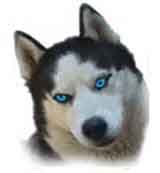Big DogsInformation About The Siberian Husky Dog Breed |
|
|
History and origin : The Siberian Husky was bred by the nomadic Chukchi tribes of northeast Asia. He was used as a sled dog and as a hunter. This medium-sized breed has great stamina and a lively, independent nature. Description : The Siberian Husky stands 20 to 23 inches at the shoulder and weighs between 35 and 60 pounds. The females are much smaller than the males. He has a medium-sized athletic body and a high-maintenance coat that sheds profusely and requires regular brushing to keep it in good condition. The undercoat is dense, giving the dog great insulation against the cold. In the spring the Husky loses much of this undercoat. Eye color for the Huskie is variable. Blue and brown are common, often one of each is seen. About the breed : Because this breed was bred to perform his task with less human control, he tends to be more intelligent and on the stubborn, independent side. The Husky loves to roam and do his own thing. He can be very resistant to training, particularly with the "Come" command. This breed can be a real character, and when he so chooses, he is loving and sweet, making him a good family dog. He is very clean and rarely gives off any doggy odors. He is also very vocal, not barking so much as yodeling in howls and yips similar to the vocalizations of wolves. This can be annoying and hard to change. Smart but obstinate, the Husky is not the easiest breed to train. He needs lots of exercise and would not be a good choice for an apartment dweller. He is also a poor watchdog because of his tendency to take off at the first sign of trouble. This breed loves to run and can make a great jogging partner, provided the weather is not too warm. Just keep in mind that the Husky has a very high prey drive and can be rather aggressive toward small dogs and other small animals. The Husky is usually friendly to almost anyone and is usually good with children. This breed can be prone to hip dysplasia and chronic diarrhea. He has a gastrointestinal tract that can overreact to changes in diet or environment. Provide the Husky with one type of food and do not change it unless necessary. Avoid leaving the dog in the kennel or he may not eat well, may get diarrhea, and may suffer from what is called kennel fever, a restless state of mind that is best described as a claustrophobic dread of confinement. Feeding : Recommended feeding for this breed is 1 ½ - 2 ½ cans (13.3oz) of high-quality meaty product with biscuit added in same amount or 5 cupfuls of a complete dry food. Ideal home : A house with a fenced yard is important. The owner of a Siberian Husky should be a firm, competent leader who likes a playful, challenging, and independent breed. Spoilers, nervous types, and overbearing persons should avoid this breed. Time to exercise and train him, especially the "Come" command is essential. The Husky is good with children, but no roughhousing should be allowed. Small animals could pose a problem due to this breed's high prey drive. The elderly and the disabled may have trouble keeping up with this active breed.Back to the Big Dog Breed article page
| |
|
Related News About Dogs ' ); // get rid of newsfeed display by carp CarpConf('poweredby',''); CarpCacheShow('http://classifieds.agriscape.com/syndicate/dogs.rss'); ?>
|
|
|
|
|
|
Copyright © 2006-2007 dogguidance.com |


